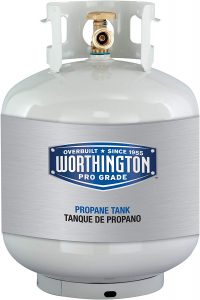Propane (for our purposes) comes in two sizes. The smallest, and most applicable for hunting and whatnot, are 1 pound tanks. Even though I’m linking to them, don’t buy online unless you’re in dire straits. Shipping propane will probably eat you alive. You should be able to get them for $4 a pop at virtually any hardware store. (I’ll discuss details about one pound tanks in a future post… stay tuned.)

More about these later.
The bigger and more cost effective tank is a plain old BBQ tank. These hold 20 pounds of propane and are available anywhere. (Here’s a link to a fancy one with a cool “fuel gauge”.) It’s cheaper to get your own one filled at a place that does that. Or for convenience you can swap an empty for a full and wind up with a crappy old refurbished one which will work just as well. Also, just buying a full refurbished one at most box hardware stores and even some grocery stores is a cheap way to go.

I suppose I have to say this (though it ought to be obvious) but lugging a 20 pound tank around by hand is stupid. This is for when you’re stationary… like at an elk hunting base camp. You’ll need an adapter hose if you choose the big twenty pounder over the small one pounder.
You have to be aware of propane’s drawbacks. First of all, propane tanks (even the little one pounders) are too heavy for backpacking. You don’t need me to tell you that. You’d figure it out on your first five mile hike. That said, if you’re carrying weight only a few miles or in a truck/ATV it’s the “no brainer” choice. It’s much simpler than other fuels.
Second, propane has a lot of water in it. If you’re using it inside, or in an RV, or whatever… it’ll get condensation all over everything if you don’t take proper precautions and vent the hell out of if. (Not to mention the fumes from any combustion in an enclosed space can kill you… but more on that in a bit.)
Also, if you’re really pushing it into the wilderness, propane is a bit twitchy with cold temperatures. If you life is on the line and it’s very cold… especially if you’re a zillion miles from any other option… be aware that propane can freeze up. That said, damn near nobody will be in such conditions and the hearty souls that do… they already know this. Also, as with anything, one can take appropriate precautions to make the technology work. All technologies have caveats and this is an article about heat, not magic.
We break here before I go on a rant about all the heaters that I’ve tried that sucked and how I finally found the one true path to happiness. Stay tuned for part 3.

Prefille 20lb bbq tanks have their place in the world but too few people realize that they’re getting 15–18lbs in a 20lb tank. They’re a great way to exchange a tank requiring inspection and worth the price premium if other propane isn’t available.
RE: 20 lb cylinders – refill, don’t exchange. Most – but not all, just most – exchange programs at retail outlets sell you a 20 lb cylinder with 15 lbs of propane in it for the price of a full 20 lbs.
25% less content for the same price as “a convenience” for not having to wait for Cletus or Billy Bob to fill your empty tank – which may also entail driving a few miles farther – or, viewed differently, 1/3 more for the same price in exchange for waiting.
If time is more important than money, exchange; if money is important, refill; if BOTH are important, keep a full spare tank on hand.
Pingback: Anti-Frozen Ball Technology: Part 4 | Adaptive Curmudgeon